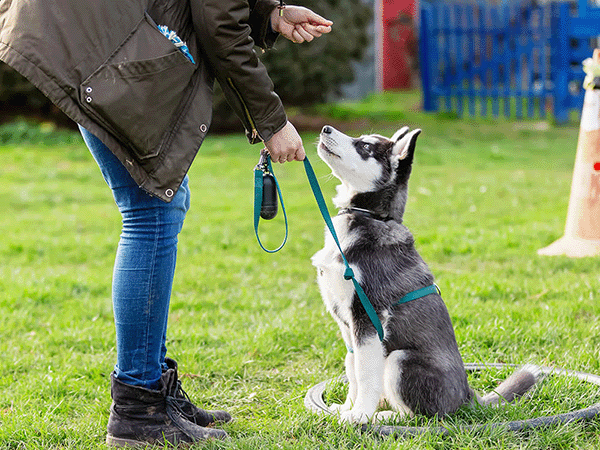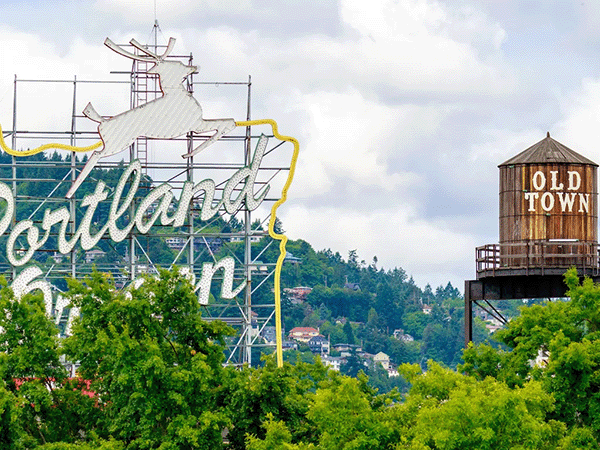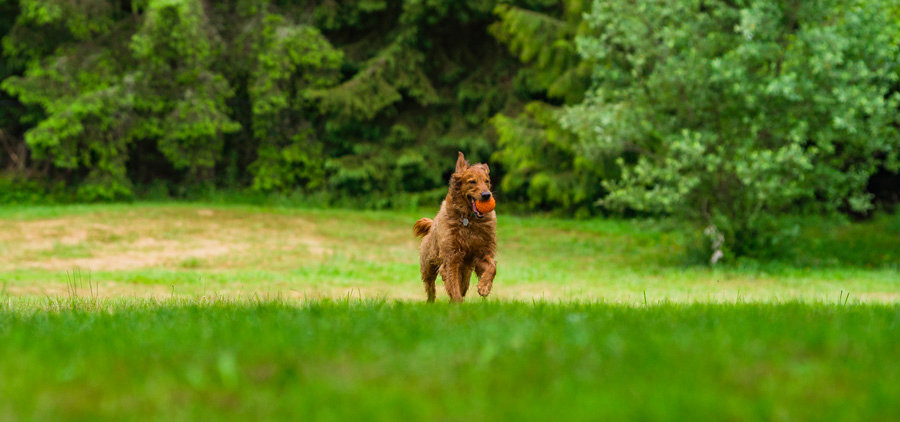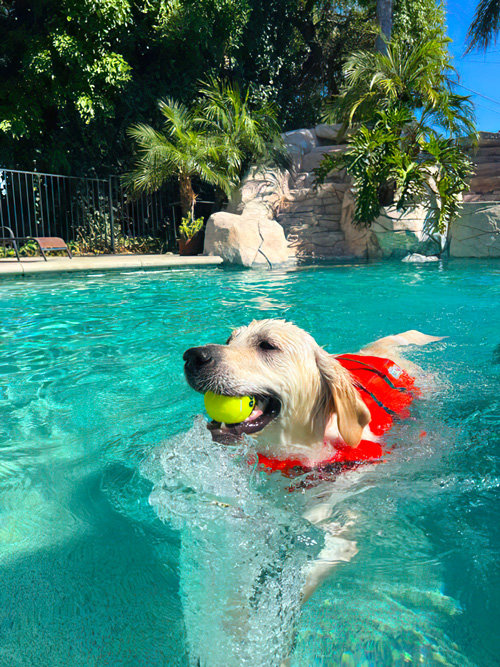Dog Fear Aggression: Signs, Causes & Solutions

* All Sniffspot articles are reviewed by certified trainers for quality, please see bottom of article for details *
It's tough to see your dog struggling with fear, especially when it looks like aggression. It's important to understand that fear aggression in dogs is often mistaken for reactivity. Let's break down the difference between the two, explore why fear aggression happens, and give you some real, practical tools to help your dog feel safer and more confident.
Some of the behaviors of reactivity and aggression may look the same: a dog displaying aggression may bark, growl, lunge, or snap, and a reactive dog may do these things as well.
According to the American Kennel Club, “aggression can be due to guarding territory or protecting a family member, resource guarding, fear, frustration, prey drive, and/or pain.” (Fear aggression is what we will specifically cover in this article, but as you can see, there are many other reasons or situations that may cause a dog to act “aggressive.”)
Reactive dogs, on the other hand, are reactive (meaning they overreact) to certain things or situations. To be considered reactive, a dog must have a trigger, such as people wearing hats, men with beards, feeling trapped while leashed, and so forth.
To complicate matters further, your dog may be showing one of the above behaviors, but that does not mean the dog is necessarily aggressive or reactive. The situation that elicits the behavior determines this. A dog may bark or growl in a certain situation, but that does not mean the dog is aggressive or reactive.
For example: If your dog barks excessively in reaction to a trigger (or triggers), like seeing a person with a hat, that is reactive behavior. If they bark in a loud and constant way because they feel cornered by a person, that is fear aggressive behavior. If they bark because they see a squirrel in a tree, that’s just barking because they see a squirrel in a tree–probably normal behavior based on their prey drive. (If the barking becomes excessive or compulsive, or if seeing the squirrel causes the dog to behave in ways that could be dangerous to the dog, it could veer into “reactive” territory.)
As you can see, identifying the behavior can be tough, and might take some practice. But don’t worry, you’re not alone and we’re here to help. In this article, we’ll cover how to identify fear aggression and how to manage and modify fear aggression.
Is Your Dog Showing Fear-Based Aggression?
A dog with fear aggression will display body postures that signal fear. These may include:
- Lip licking
- Baring teeth
- Cowering
- Growling, lunging, snapping or biting if cornered
- Nipping at the “scary” person as they walk away
- Inflicting shallow, rapid bites on the person
Much of fear aggression occurs when the dog feels cornered. According to the ASPCA, dogs, like most animals, would prefer to get away from the perceived threat. They become aggressive when they feel it is their only recourse. A dog exhibiting fear aggression is trying to protect themselves from the thing that is scaring them.
What this means is that we can (in some cases) prevent fear from turning into fear aggression by becoming more familiar with body language cues from our dogs.
Here are some body language cues that indicate your dog is stressed or worried:
- Body freezing
- Lip licking or tongue flicking
- “Whale eye”: when a dog turns their head but keeps their eyes on you (or on the perceived threat), showing a large amount of the whites of their eyes
- Lip licking
- Yawning (depending on the situation–the dog may also simply be tired)
- Facial tension/ tensed jaw
- Hair on neck and back standing up
- A lowered body
Being able to recognize these signs of stress can help you remove your dog from the situation (when possible) and prevent fear aggression altogether. If, for example, your friend is approaching your dog and you notice the dog licking their lips or freezing, intervene and direct your friend away from the dog, and give the dog a safe space to retreat to. This cuts the situation off before it reaches the point where the dog feels they have no choice but to act aggressive.
If displaying fear aggression is a last resort, we can take steps to keep the dog from feeling the need to resort to it.
Key Takeaways
- Understand the difference between fear aggression and reactivity: Fear aggression is a response to perceived threats, while reactivity is triggered by specific stimuli. Knowing the difference is the first step to addressing your dog's behavior.
- Manage your dog's environment and learn their body language: Minimize exposure to triggers and create a safe space for your dog to retreat. By recognizing subtle signs of fear, you can intervene before their fear escalates into aggression.
- Work with a professional and use positive reinforcement: Consult a certified dog trainer or veterinary behaviorist for a personalized behavior modification plan. Positive reinforcement training, combined with counter-conditioning and desensitization, can help your dog overcome their fear.
Understanding Fear Aggression
What is Fear Aggression in Dogs?
Fear aggression in dogs happens when a dog feels threatened, whether the threat is real or perceived. This fear can manifest in behaviors like panting, lip-licking, or snapping. Sometimes, what looks like aggression is actually reactivit, and it's important to understand the difference. A reactive dog overreacts to specific triggers, while a fear-aggressive dog is responding to a perceived threat to their safety. For example, a reactive dog might bark excessively at someone wearing a hat, while a fear-aggressive dog might growl and snap if they feel cornered by a stranger.
Recognizing the Signs
A dog experiencing fear aggression will show signs of fear in their body language. These can range from subtle indicators like lip licking and yawning to more obvious signs like cowering and baring teeth. Other signs might include growling, lunging, or even biting if they feel trapped. It's important to remember that these behaviors are a dog's way of communicating their fear and discomfort. Learning to recognize these signs can help you understand your dog's emotional state and take steps to help them feel safer. If you notice your dog exhibiting any of these behaviors, it's crucial to avoid approaching them directly, as this could escalate the situation. Instead, try to create space and allow them to retreat to a safe area.
Why Dogs Develop Fear Aggression
Common Causes
Several factors can contribute to fear aggression in dogs. A lack of proper socialization as a puppy is a major one. Early exposure to a variety of sights, sounds, people, and other animals can help puppies develop into confident, well-adjusted adults. Traumatic experiences, such as being attacked by another dog or being involved in a car accident, can also lead to fear aggression. Additionally, using punishment-based training methods, especially with harsh tools like choke chains, can create fear and anxiety, potentially increasing the likelihood of aggressive behavior. Genetics can also play a role, with some breeds being more predisposed to anxiety and fear-related behaviors.
The Importance of Early Socialization
Early socialization is crucial for preventing fear aggression. The period between 3 and 16 weeks of age is especially important for puppies. During this time, they are most receptive to new experiences. Exposing them to a wide range of positive interactions with people, dogs, and different environments can help them develop into well-adjusted adults. This early exposure helps build confidence and reduces the likelihood of developing fear-based behaviors later in life. Think of it as building a solid foundation for a happy, well-behaved dog. Finding safe and controlled environments for these early interactions is key, and places like Sniffspot can provide excellent opportunities for positive socialization experiences.
Managing Fear Aggression in Dogs
Management
- Intervention: As mentioned above, intervening in a situation that might lead to fear aggression is a key way to manage it. Practice reading your dog’s body language, and use that knowledge to intervene in situations that you notice are stressing your dog out. You can also do this preemptively: for example, if your dog is stressed out by your child, always place yourself between the dog and the child when you are in a room together. Alternatively, put the dog’s bed in an area the child does not have access to (if possible). Set your dog up for success in any way you can given the situation. The key here is to cut off fearful situations at the root whenever possible.
- Rituals of behavior: Dog trainer Victoria Stillwell also recommends creating “rituals of behavior”, which she describes as “actions and behaviors your dog can practice any time she is in a situation that might make her uncomfortable.” These are tasks that keep your dog working and thinking, which will help the dog stay below their stress threshold. The rituals of behavior will be different depending on the situation, and you can make up any ritual that you want. (On the aforementioned page, Stillwell gives an example of a ritual for when someone new to the dog comes over.)
- Priming: Priming simply means doing something to put your dog in a happy mood before they encounter a stressor (or multiple stressors). If you know your dog is going to encounter a stressor later, do something they like first, such as playing fetch or another game they like. The principle here is that the dog is better able to deal with a stressful situation if they’re in a good mood going into it–just like humans!
Modification:
As the ASPCA states, it’s very important to work with both your veterinarian and a professional dog behavior expert when dealing with any issue of aggression. The veterinarian can help you make sure your dog isn’t acting aggressive out of pain or illness. (It’s important to eliminate this possibility first.) The behavior expert should be experienced in working with dogs with fear aggression. They can help you figure out a plan for behavior modification based on your dog’s history and risk factors. The plan will most likely involve counterconditioning and desensitization.
It’s important to bring in a professional behavior expert because any dog that acts aggressive comes with certain risks (which are outlined in the ASPCA article in the above paragraph). For instance, a dog with a history of biting people is an insurance liability and can be at risk for euthanization (in some places). You do not want your dog to hurt you, other people, or other animals. Our article When And How To Think About Medication For Anxious Dogs contains a breakdown of the difference between vets, veterinary behaviorists, and certified applied animal behaviorists. The American Kennel Club also has a handy guide to choosing a dog trainer.
Dealing with fear aggression in dogs can be scary, but with some professional help, the ability to read your dog’s body language, and a lot of patience, you can help your dog be less afraid, and improve the quality of life for both of you.
Creating a Safe Environment
Building a Safe Haven
One of the most important things you can do for a fearful dog is to create a safe haven. This should be a quiet, comfortable space where your dog can retreat when feeling overwhelmed. Think of it as their own personal sanctuary, free from stressors and perceived threats. This could be a crate, a dog bed in a quiet corner, or even a whole room, depending on your dog's preferences and your home layout. Make it extra cozy with blankets, familiar toys, and maybe even a calming pheromone diffuser. The goal is to provide a predictable, secure environment where your dog can relax and de-stress. You can even teach your dog a "go to your place" cue, so they can choose to remove themselves from a situation before their fear escalates. Having a safe haven can significantly reduce anxiety and promote a sense of security in fearful dogs. For more tips on creating a safe space, check out this helpful resource from Veterinary Partner.
Minimizing Triggers
Managing a dog's environment to minimize exposure to their fear triggers is crucial. If you know what frightens your dog—whether it's loud noises, strangers, or certain objects—do your best to avoid those situations, especially in the early stages of behavior modification. If complete avoidance isn't possible, try to create distance between your dog and the trigger. For example, if your dog is afraid of other dogs, choose walking routes that are less populated. Consider using a private dog park through Sniffspot to help your dog socialize in a controlled environment. If visitors trigger your dog's fear, manage the introductions carefully, perhaps by having guests toss treats to your dog from a distance. Using clear signals like "Do Not Pet" signs can also help prevent unwanted interactions and create a more predictable, less stressful environment for your dog. This article from Veterinary Partner offers further guidance on environmental management for anxious dogs.
Training and Behavior Modification Techniques
Positive Reinforcement Training
Positive reinforcement training forms the cornerstone of behavior modification for fear aggression. This involves rewarding your dog for calm, relaxed behaviors, especially in the presence of their fear triggers. Start with low-intensity triggers and gradually increase the intensity as your dog progresses. For example, if your dog is afraid of men with beards, start by rewarding them for staying calm when a bearded man is far away. As your dog becomes more comfortable, gradually decrease the distance. Keep training sessions short, positive, and always end on a successful note. Consistency is key, so make positive reinforcement a regular part of your dog's routine. This blog post offers a deeper look into positive reinforcement for fear aggression. You can also find a list of top dog trainers on Sniffspot to help guide you through this process.
Counter-Conditioning and Desensitization
Counter-conditioning and desensitization are powerful techniques for changing a dog's emotional response to their fear triggers. Desensitization involves gradually exposing your dog to their fear triggers at a low intensity, while counter-conditioning pairs the trigger with something positive, like a tasty treat or a favorite toy. The goal is to change the dog's association with the trigger from negative to positive. For example, if your dog is afraid of the vacuum cleaner, start by having it turned off in the same room, rewarding your dog for staying calm. Gradually move the vacuum closer, continuing to reward calm behavior. Eventually, you can turn the vacuum on briefly, still pairing it with positive reinforcement. Over time, your dog will learn to associate the vacuum with good things, reducing their fear. This resource provides a comprehensive overview of counter-conditioning techniques.
Seeking Professional Guidance
Working with a qualified professional is essential when dealing with fear aggression. A certified professional dog trainer or a veterinary behaviorist can assess your dog's individual needs and develop a tailored behavior modification plan. They can also help you identify underlying causes of fear aggression and address any safety concerns. A veterinarian can rule out any medical conditions that might be contributing to your dog's fear. Early intervention is crucial, so don't hesitate to seek professional help if you're concerned about your dog's behavior. Resources like the American Kennel Club website offer guidance on finding qualified trainers. Remember, working with a professional can significantly improve the effectiveness of your training efforts and ensure the safety of both you and your dog.
Vetted by a Certified Dog Trainer
There is so much misinformation out there, we want to make sure we only provide the highest quality information to our community. We have all of our articles reviewed by qualified, positive-only trainers. The trainers that review our content are reviewed by other trainers to ensure that we have the best quality filters on our content.
This is the trainer that reviewed this article:
Lindy Langum
Founder – K9 Fun Club
Staff Trainer – Summit Assistance Dogs
Certified in Canine Studies (CSS), NW School of Canine Studies
Finding the Right Resources for Your Dog
When dealing with fear aggression in dogs, finding the right resources is crucial for effective management and behavior modification. It's important to understand that fear aggression is often a dog's response to perceived threats. As the ASPCA notes, "dogs, like most animals, would prefer to get away from the perceived threat. They become aggressive when they feel it is their only recourse." This highlights the importance of recognizing those early signs of fear and intervening before the dog's fear escalates into aggression.
To effectively manage fear aggression, working closely with both a veterinarian and a certified professional dog trainer or behaviorist is recommended. Your veterinarian can rule out any underlying medical conditions that might be contributing to the behavior, while a behavior expert can create a tailored behavior modification plan. This plan will likely include techniques like counter-conditioning and desensitization, which are essential for helping your dog feel more secure in stressful situations. For help finding a qualified trainer near you, check out the Certification Council for Professional Dog Trainers.
Understanding your dog's body language is also key. Recognizing signs of stress, such as lip licking, body freezing, and "whale eye" (when a dog turns their head but keeps their eyes on you or the perceived threat, showing a large amount of the whites of their eyes), can indicate that your dog is feeling threatened. You can find more information on canine body language at PetMD. By recognizing these cues early, you can intervene and prevent situations from escalating. For more tips on reading your dog's body language, check out our article on How to Read Your Dog's Body Language.
Finally, creating a safe environment for your dog is paramount. This might involve setting up a safe space where your dog can retreat when feeling anxious, and minimizing their exposure to known triggers. Victoria Stillwell suggests establishing "rituals of behavior," which are actions your dog can practice in uncomfortable situations to keep them engaged and focused. Finding safe and enriching spaces for your dog to explore and de-stress is also helpful. Check out Sniffspot to find dog parks near you.
Related Articles
- Dog Barrier Reactivity and Frustration Training | Sniffspot
- How to Treat Puppy Leash Aggression | Causes and Training
- Dog Reactivity Training | When Your Dog Reacts to Other Dogs
- German Shepherd Dog Aggression Causes, Myths, and Training
- How to Socialize Your Reactive or Unsocialized Adult Dog
Frequently Asked Questions
Is my dog’s aggression really reactivity? It can be tricky to tell the difference between aggression and reactivity. Reactive dogs overreact to specific triggers, while aggressive dogs may react for a variety of reasons, including fear. If your dog's behavior involves triggers like specific objects or people, it might be reactivity. If the behavior seems tied to feeling threatened or cornered, it could be fear-based aggression. It's always best to consult with a certified professional to get a proper diagnosis.
What are the most common signs of fear aggression? A fear-aggressive dog often displays a combination of fear and aggression signals. Look for fearful body language like lip licking, tucked tails, yawning, and whale eye (showing the whites of their eyes). These can be combined with aggressive displays like growling, lunging, snapping, or biting, especially when the dog feels trapped or cornered.
My dog has bitten someone. What should I do? A bite incident is serious and requires immediate action. First, ensure everyone involved is safe and seek medical attention if needed. Then, consult with a veterinarian to rule out any underlying medical conditions that might be contributing to the behavior. Most importantly, work with a certified professional dog trainer or veterinary behaviorist experienced in aggression cases. They can assess your dog's behavior and create a safe and effective behavior modification plan.
How can I prevent fear aggression from developing in my puppy? Early socialization is key. Expose your puppy to a variety of positive experiences with different people, dogs, and environments during their critical socialization period (between 3 and 16 weeks of age). Focus on positive reinforcement training methods, rewarding desired behaviors and avoiding punishment-based techniques. Creating a safe, predictable environment for your puppy can also help prevent fear-based behaviors from developing.
What kind of professional help should I seek for my dog's fear aggression? Look for a certified professional dog trainer, a certified applied animal behaviorist, or a veterinary behaviorist with experience in aggression cases. Your veterinarian can also be a valuable resource, helping to rule out any medical causes for the behavior and potentially recommending behavior professionals in your area. Be sure to choose a professional who uses positive reinforcement methods and avoids aversive techniques.
Most recent articles
Related articles
Top dog guides per area
Dog training guides

Dog Food Aggression: Why You Shouldn't Punish It
Does your dog ever growl when you walk by their food dish? Maybe they get possessive of treats, carrying them far away and giving you side-eye when you start to approach — or snarling at your other pets or children if they get too close.

Best Dog Fields in the US: 25+ Wide-Open Spaces for Your Pup to Run Free
The best dog fields in the US offer something that traditional enclosed parks simply can't match: acres of open space where your pup can truly stretch their legs and run at full speed. From Colorado's 470-acre prairie meadows to Tennessee's award-winning "Outback," these wide-open spaces allow dogs to roam, explore, and exercise naturally while engaging instincts that cramped urban parks suppress.

The Ultimate Guide to Scent Training for Dogs
Your dog's nose is an amazing tool. Did you know they have 40 times the olfactory receptors than humans? Scent training for dogs taps into this superpower, turning everyday moments into exciting sniff-fests. It's enriching for all types of dogs – reactive, shy, or simply adventurous. Ready to explore the world of scent work for dogs? Let's get started.

Service Dog Training Costs: DIY vs. Pro
More than 80 million Americans rely on their service dogs to help them navigate the world. Task-trained assistance animals perform a huge range of life-changing—in many cases, life-saving—services: These dogs act as eyes for visually impaired handlers, provide mobility support, alert to seizures and blood sugar crashes, interrupt anxiety attacks, remind their people to take medications, and so much more.

How to Deal With Puppy Potty Training Regression
You thought those dreaded middle-of-the-night potty breaks were over. You were finally free from cleaning up puppy puddles. Then, suddenly, your furry friend starts having accidents again. It's frustrating, right? This puppy potty training regression is more common than you think. Don't worry; we'll help you get your pup back on track. We'll cover the common causes, offer practical solutions, and give you actionable steps to tackle this challenge together.

Dirty Dog Syndrome: Causes, Solutions, and Prevention
It's a cringe-worthy moment every dog owner dreads: your furry friend chowing down on something truly disgusting. If your dog has a penchant for poop, you're dealing with coprophagia. It's more common than you think, and thankfully, often manageable. This article explores the reasons behind dirty dog syndrome, from instinct to learned behavior. We'll also give you practical tips to help break this unpleasant habit.

How to Train Your Rescue Dog: A Complete Guide
* All Sniffspot articles are reviewed by certified trainers for quality, please see bottom of article for details *
Dog enrichment guides

Best Dog Water Parks in the US: 15+ Amazing Splash Destinations for Your Pup
Do you have a water-loving dog looking to burn some energy? There are countless dog parks to visit throughout our country — but some of them become far too hot in the midday sun to be safe for your pets to play. That’s why we’ve put together a list of some of the best dog water parks throughout the United States! At these locations, your pup can frolic, splash, and swim to their heart’s content.

Best Dog Fields in the US: 25+ Wide-Open Spaces for Your Pup to Run Free
The best dog fields in the US offer something that traditional enclosed parks simply can't match: acres of open space where your pup can truly stretch their legs and run at full speed. From Colorado's 470-acre prairie meadows to Tennessee's award-winning "Outback," these wide-open spaces allow dogs to roam, explore, and exercise naturally while engaging instincts that cramped urban parks suppress.

Best Toys for Herding Dogs: Keeping Your Pup Happy & Engaged
Herding dogs are amazing, intelligent companions. But that also means they need more than just a simple game of fetch. Finding the right toys for herding dogs is key to keeping them happy and stimulated. This article explores some of the best toys for herding dogs, including options specifically for breeds like Border Collies and Australian Shepherds. We'll help you discover the perfect herding toys for dogs to tap into their natural instincts and keep them entertained for hours.

Tough Dog Toys for Aggressive Chewers: A Practical Guide
Does your dog destroy every toy you give them? Is your house littered with the remnants of plush toys? Are you tired of wasting money on "indestructible" dog toys for aggressive chewers that don't last? Then this post is for you. We'll cover everything you need to know about finding the best dog toys for aggressive chewers, so you can finally give your pup something safe, durable, and fun.

Daily Exercise Calculator: How Much Exercise Does Your Dog Need?
Everyone knows dogs need exercise, but how much is enough? Walks are great, but creating a truly balanced fitness plan means understanding your dog's specific needs. This post helps you develop a daily exercise calculator for your dog, considering breed, age, and lifestyle. We'll cover fun activities, understanding exercise intensity, and recognizing when your pup has had enough. Let's create a plan that keeps your dog happy and healthy!

Complete Guide To Herding With Dogs
* All Sniffspot articles are reviewed by certified trainers for quality, please see bottom of article for details *

Dog Enrichment Activities: The Ultimate Guide
Ever feel like your dog is restless or bored? They may be getting enough exercise, but still need more. That's where enrichment activities for dogs come in. Giving your dog opportunities to sniff, explore, and problem-solve can make a world of difference. Whether you have a puppy, adult, or senior dog, enriching their environment is key for their well-being. Let's explore how to add cognitive enrichment for dogs, even tailoring activities to your dog's breed with breed specific enrichment and fun enrichment games for dogs.
Dog reactivity guides

Rottweiler Aggression: Truth vs. Myth
Many dogs have gotten a bad reputation over the years for being "dangerous breeds." Rottweilers are among them. Like pit bulls and other large, blocky-headed types of dogs, these powerful and beautiful animals are often assumed to be aggressive.

Best Dog Fields in the US: 25+ Wide-Open Spaces for Your Pup to Run Free
The best dog fields in the US offer something that traditional enclosed parks simply can't match: acres of open space where your pup can truly stretch their legs and run at full speed. From Colorado's 470-acre prairie meadows to Tennessee's award-winning "Outback," these wide-open spaces allow dogs to roam, explore, and exercise naturally while engaging instincts that cramped urban parks suppress.

What Is a Reactive Dog? A Practical Guide for Owners
Does your dog suddenly transform into a barking, lunging Tasmanian devil on walks? It's stressful for both of you. If this sounds familiar, you might have a reactive dog. Understanding what is a reactive dog is the first step to calmer walks. We'll explore the common triggers and give you actionable strategies to manage and modify this behavior. Let's turn those stressful walks into enjoyable outings.

How to Socialize a Reactive Dog: A Step-by-Step Guide
Does your dog display reactivity to other pets or people? Maybe they’re a new rescue pup and are still settling into your home. Or they were sick growing up, so you missed their critical socialization period. Possibly they’ve had a bad experience after being raised as a normal puppy.

What Is a Reactive Dog? A Complete Guide
Is your dog overly excited or fearful around other dogs? Do they bark, lunge, or whine? You might have a reactive dog. Many dog owners face this challenge. Understanding what a reactive dog is is the first step to helping them. This guide explores the common causes of dog reactivity, explains what makes a dog reactive, and offers practical tips and resources. Let's work together to build a stronger bond with your dog and enjoy stress-free walks.

9 Best Online Communities for Reactive Dog Parents
Does your dog's reactivity make walks stressful? You're not alone. Many dog owners face similar challenges. This guide offers practical advice and support for managing reactivity, including finding the best online dog training for reactive dogs. We'll connect you with reactive dog support groups, share training tips, and explore resources like the best dog training app for reactive dogs. Let's build a stronger bond with your dog, together.
* All Sniffspot articles are reviewed by certified trainers for quality, please see bottom of article for details *
How To Groom a Reactive Dog
* All Sniffspot articles are reviewed by certified trainers for quality, please see bottom of article for details *
Sniffspot community guides

The State of Public Dog Parks Across the United States
From 2009 to 2020, there was a 40 percent increase in the development of public dog parks. Designated spots for canine exercise have become commonplace in every major city in North America — many pet owners won’t even consider renting an apartment that doesn’t have its own fenced-in pet area for their canine companions.

Best Dog Fields in the US: 25+ Wide-Open Spaces for Your Pup to Run Free
The best dog fields in the US offer something that traditional enclosed parks simply can't match: acres of open space where your pup can truly stretch their legs and run at full speed. From Colorado's 470-acre prairie meadows to Tennessee's award-winning "Outback," these wide-open spaces allow dogs to roam, explore, and exercise naturally while engaging instincts that cramped urban parks suppress.

How This Family is Affording Their Dream Property Through Renting it Hourly to Dogs
Thousand Oaks, California has been a safe haven for Sniffspot host, Jen, since childhood. Having grown up in busy Santa Barbara, Jen, an introvert from an early age, would seek out solitude and serenity away from tourists attractions and droves of people visiting from elsewhere. “My grandparents own 60 acres about a 30 minute drive from here, and I grew up spending every summer and every holiday visiting them on the ranch,” Jen explained. “In Santa Barbara, we wouldn't go to the beach on the weekend because that's where everybody was, so you'd find places off the beaten path where the tourists weren't. For me, the ranch was just my happy place.”

Host Tips: Ellen K. What Makes Sniffspot Successful for Me
Ellen is the host of Country Pasture Getaway, one of Sniffspot's most popular sniff spots. She has taken the time to write up the lessons she has learned about how to be a great sniff spot host.

How this Oregon Farmer is Making a Business From Renting Her Land to Dogs
Just 20 minutes outside of the busy city of Portland, Oregon, and settled right on the banks of the Columbia River, you’ll find what countless visitors have flocked to the area in search of – mountain views, crisp, clean air, and running water for miles. What you might not expect to find, however, is a hidden oasis designed just for dogs and their people, owned and operated by a farming couple and enjoyed by visitors on two legs, and four.

Host Tips: Fran T. Providing Great Guest Service at our Spot
Fran is the host of Ranch Setting, one of Sniffspot's most popular spots. She has taken the time to write up the lessons she has learned about how to be a great Sniffspot host.

How Sniffspot Helped a Nervous Rescue Work Through His Fears and Change His Family’s Life
This is the story of a family and dog rescuing each other.
Top dog trainers in the US

The Best Dog Trainers in the United States of 2025
This is a list of the top dog trainers in the United States, based on votes from the Sniffspot community and the general public.
The Best Dog Trainers in Seattle, WA of 2025
This is a list of the top dog trainers in Seattle, WA, based on votes from the Sniffspot community and the general public.
The Best Dog Trainers in Portland, OR of 2025
This is a list of the top dog trainers in Portland, OR, based on votes from the Sniffspot community and the general public.
The Best Dog Trainers in Los Angeles, CA of 2025
This is a list of the top dog trainers in Los Angeles, CA, based on votes from the Sniffspot community and the general public.
The Best Dog Trainers in New York, NY of 2025
This is a list of the top dog trainers in New York, NY, based on votes from the Sniffspot community and the general public.
City dog parks guides

Top 10 Indoor Dog Parks: A US Guide
Looking for a space to play with your dog no matter what the weather’s like outside? Look no further than our list of the best indoor dog parks in the United States! These climate-controlled spaces are growing in popularity as pet ownership increases throughout the country. As a bonus, many of them also offer dog training, boarding, grooming, or daycare services on the premises.

Best Dog Fields in the US: 25+ Wide-Open Spaces for Your Pup to Run Free
The best dog fields in the US offer something that traditional enclosed parks simply can't match: acres of open space where your pup can truly stretch their legs and run at full speed. From Colorado's 470-acre prairie meadows to Tennessee's award-winning "Outback," these wide-open spaces allow dogs to roam, explore, and exercise naturally while engaging instincts that cramped urban parks suppress.

Best Dog Parks in the US: Ultimate Guide to Public & Private Off-Leash Adventures
Is your pup giving you those pleading "let me run free" eyes? Whether you're a new dog parent or a seasoned pro looking for fresh adventures, finding the perfect off-leash paradise for your furry friend can feel ruff! From sun-soaked California beaches where your water-loving lab can make a splash to mountain trails in Vermont where your adventure buddy can chase every scent, we've sniffed out the 15 best dog parks across America.

Dog Parks Near Me: Las Vegas Edition
Looking for the perfect dog park near me in Las Vegas? You're in luck! This guide explores all the best options for your pup, from public dog parks to private dog parks near me on Sniffspot. We'll help you find the ideal spot for playtime, socializing, and fresh air. Plus, we'll cover essential etiquette and safety tips to ensure a happy visit for everyone. Get ready for some tail-wagging fun!

Top Sniffspot Locations: Find the Perfect Dog Park
Looking for the perfect dog park? Whether you need a wide-open public space or a private, fenced-in spot, this guide will help you find the best dog parks across the US. We'll cover top-rated public parks, the perks of private dog parks, and even explore Sniffspot locations – giving your pup a safe and fun place to play. Ready to find your dog's new favorite spot? Let's go!

Sniffspot: Portland's Best Private Dog Parks
Ready to discover Portland's best dog parks? Whether you're looking for a public park or the unique experience of a private Sniffspot, this guide has you covered. We'll help you find the perfect spot for your pup, with tips on what to bring, how to prepare, and even understanding dog body language. Plus, we'll explore some top Portland dog parks, including public and Sniffspot options, so you can plan your next dog-friendly adventure in the City of Roses.
Portland Dog Parks: Public & Private Options
This page is about public city dog parks and also includes Sniffspot private dog parks. Sniffspot is the largest network of private dog parks for rent in the world!
Small Dog Park Guide: Tips for Finding the Perfect Spot
Finding the perfect dog park for your small breed can be ruff! Big dog parks can be overwhelming, even dangerous, for little pups. This comprehensive guide helps you sniff out the best small dog parks for your pint-sized companion, covering everything from essential safety checklists to top recommendations for small dog parks across the US—including both public spots and private dog parks.
Dogs breeds

German Shepherd Dogs: Insights From Real Dog Owners
The German Shepherd Dog (GSDs) are known for their intelligence, loyalty, and striking appearance. They're also incredibly versatile, excelling as working dogs and devoted family companions. This guide covers everything you need to know about GSDs, from understanding their unique traits and rich history to practical advice on training and care. So, whether you're a seasoned GSD owner or just starting your research, let's explore this remarkable breed together.

Best Dog Fields in the US: 25+ Wide-Open Spaces for Your Pup to Run Free
The best dog fields in the US offer something that traditional enclosed parks simply can't match: acres of open space where your pup can truly stretch their legs and run at full speed. From Colorado's 470-acre prairie meadows to Tennessee's award-winning "Outback," these wide-open spaces allow dogs to roam, explore, and exercise naturally while engaging instincts that cramped urban parks suppress.

Labrador Retriever: Ultimate Guide by Owners
Discover the Labrador Retriever, a breed celebrated for its playful nature, affectionate temperament, and trainability. Labradors are known for their friendly demeanor and adaptability, making them perfect family companions and versatile working dogs. As one of the most popular types of retrievers, Labs are ideal companions for various lifestyles and are recognized by the American Kennel Club (AKC) as an excellent breed for families.

Golden Retriever Advice: The Complete Owner's Guide
Golden Retrievers: they're gorgeous, playful, and incredibly popular. But before you welcome one into your home, you need the right golden retriever advice. This guide draws on the wisdom of nearly 10,000 Golden Retriever owners, offering practical tips for caring for these affectionate dogs. From understanding their high energy levels to mastering grooming and training, we'll cover everything you need to know. So whether you're already a devoted Golden parent or just starting your research, get ready to learn how to give your furry friend the best possible care.

American Staffordshire Terrier: Your Complete Guide
Think American Staffordshire Terriers are tough? Think again. While their muscular build might intimidate some, these dogs are known for their playful and loyal personalities. This guide draws on the experience of nearly 10,000 AmStaff owners to reveal the truth about this often misunderstood breed. Want to learn more about caring for an American Staffordshire Terrier? You're in the right place.

Australian Shepherd Facts: Breed Info & Care Guide
Discover the Australian Shepherd, an AKC breed celebrated for its trainable, playful, and affectionate nature. Despite its name, the Australian Shepherd is actually a native breed to the United States, originally developed to breed on farms and ranches. Considered a medium dog, Australian Shepherds were bred for herding beginning in the 1950s. As one of the high-energy breeds, Aussies are known for their boundless energy and need for regular exercise, including aerobic exercise.

Essential Husky Facts for Owners: Breed Guide
Discover the Siberian Husky, a breed celebrated for its curious, intelligent, and loyal nature. Considered a medium-sized dog, Siberian Huskies were originally bred in Russia for sledding, beginning in the early 20th Century. Today, they're one of the most popular active breeds in North America.





























